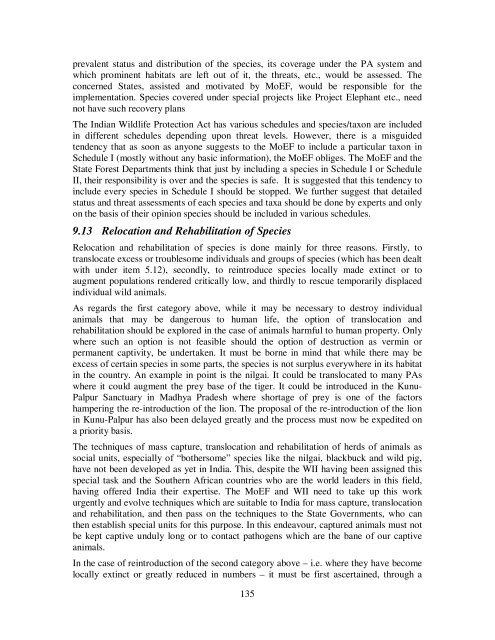Wildlife and Nature Conservation - Centre for Ecological Sciences
Wildlife and Nature Conservation - Centre for Ecological Sciences
Wildlife and Nature Conservation - Centre for Ecological Sciences
Create successful ePaper yourself
Turn your PDF publications into a flip-book with our unique Google optimized e-Paper software.
prevalent status <strong>and</strong> distribution of the species, its coverage under the PA system <strong>and</strong>which prominent habitats are left out of it, the threats, etc., would be assessed. Theconcerned States, assisted <strong>and</strong> motivated by MoEF, would be responsible <strong>for</strong> theimplementation. Species covered under special projects like Project Elephant etc., neednot have such recovery plansThe Indian <strong>Wildlife</strong> Protection Act has various schedules <strong>and</strong> species/taxon are includedin different schedules depending upon threat levels. However, there is a misguidedtendency that as soon as anyone suggests to the MoEF to include a particular taxon inSchedule I (mostly without any basic in<strong>for</strong>mation), the MoEF obliges. The MoEF <strong>and</strong> theState Forest Departments think that just by including a species in Schedule I or ScheduleII, their responsibility is over <strong>and</strong> the species is safe. It is suggested that this tendency toinclude every species in Schedule I should be stopped. We further suggest that detailedstatus <strong>and</strong> threat assessments of each species <strong>and</strong> taxa should be done by experts <strong>and</strong> onlyon the basis of their opinion species should be included in various schedules.9.13 Relocation <strong>and</strong> Rehabilitation of SpeciesRelocation <strong>and</strong> rehabilitation of species is done mainly <strong>for</strong> three reasons. Firstly, totranslocate excess or troublesome individuals <strong>and</strong> groups of species (which has been dealtwith under item 5.12), secondly, to reintroduce species locally made extinct or toaugment populations rendered critically low, <strong>and</strong> thirdly to rescue temporarily displacedindividual wild animals.As regards the first category above, while it may be necessary to destroy individualanimals that may be dangerous to human life, the option of translocation <strong>and</strong>rehabilitation should be explored in the case of animals harmful to human property. Onlywhere such an option is not feasible should the option of destruction as vermin orpermanent captivity, be undertaken. It must be borne in mind that while there may beexcess of certain species in some parts, the species is not surplus everywhere in its habitatin the country. An example in point is the nilgai. It could be translocated to many PAswhere it could augment the prey base of the tiger. It could be introduced in the Kunu-Palpur Sanctuary in Madhya Pradesh where shortage of prey is one of the factorshampering the re-introduction of the lion. The proposal of the re-introduction of the lionin Kunu-Palpur has also been delayed greatly <strong>and</strong> the process must now be expedited ona priority basis.The techniques of mass capture, translocation <strong>and</strong> rehabilitation of herds of animals associal units, especially of “bothersome” species like the nilgai, blackbuck <strong>and</strong> wild pig,have not been developed as yet in India. This, despite the WII having been assigned thisspecial task <strong>and</strong> the Southern African countries who are the world leaders in this field,having offered India their expertise. The MoEF <strong>and</strong> WII need to take up this workurgently <strong>and</strong> evolve techniques which are suitable to India <strong>for</strong> mass capture, translocation<strong>and</strong> rehabilitation, <strong>and</strong> then pass on the techniques to the State Governments, who canthen establish special units <strong>for</strong> this purpose. In this endeavour, captured animals must notbe kept captive unduly long or to contact pathogens which are the bane of our captiveanimals.In the case of reintroduction of the second category above – i.e. where they have becomelocally extinct or greatly reduced in numbers – it must be first ascertained, through a135
















